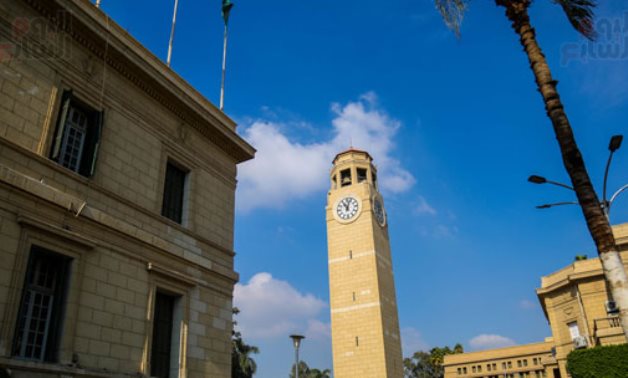
Cairo University Clock - et
CAIRO - 27 December 2022: Egypt Today was keen to pay a special tour to the historic building of the Cairo University Clock, especially after its development, in order to see the details of its establishment, the dynamics of work, and the clock ticks.
Different generations of Egyptians will relate to the phrase "Cairo University clock chimed," which was broadcast on Egyptian radio for years.
The Cairo University Clock building carries historical stories, events, details and structural engineering, especially as it is the second oldest memorial clock in the world after the famously known, Big Ben in England.
Dr. Mohsen Salih, Vice Dean of the Faculty of Archeology at Cairo University, said that the Cairo University clock is one of the main landmarks in the university, explaining that the foundation stone for the Cairo University clock was laid in 1935 and inaugurated in 1937, which is, about 88 years ago.
The clock is a symbol for the importance of time, because any nation with a civilization must be concerned with the element of time, as it is the acquisition of knowledge, achievement, experience, and work.
Dr. Mohsen Salih added that the Cairo University clock is considered one of the important signs of the university, and it is a square-shaped construction from the ground up and rises to about 42 meters, equivalent to a height of 14 floors, and is considered of architectural value, especially since the land on which the university clock is built was an agricultural land, because it was built in the area of the Palace of the family of Muhammad Ali.
The Vice Dean of the Faculty of Archeology at Cairo University explained the mechanism of the clock, explaining that the clock has a main motor and a control clock connected to the clock from the top by means of “wires” that connect the mechanical movement from the main clock located at the bottom of the building to the upper clock.
The clock includes 5 bells made of bronze. They come in different sizes, including 2 of medium size, 2 of small size, and a bell in the middle of the 4 of large size. The aim of this diversity is to have what is called tone and vocal harmony from simple to loud.
The clock is on a square section that rises to 42 meters and is a mixture of ancient Pharaonic architectural influences and symbolizes the shape of the obelisk, and has 4 main directions.
The sound of Cairo University clock bells was broadcast live on all radio stations until 1947, when Egypt was under British occupation and King Farouk at that time, but then, the political and economic conditions was difficult amid the intervention of British colonialism, which prompted Cairo University students at that time to take to the streets and denounce the British interference in the internal Egyptian affairs. A number of university students climbed the walls of the clock building, which was directly connected to the Egyptian radio.
The students then broadcast a statement denouncing and chanting "Down with colonialism and down with the king!" On the Egyptian radio, recording the ticks of the clock.
Durting the visit of former US President Obama to Egypt in 2009, after his inauguration, when he came to the grand celebration hall and had an important meeting with the university administration, he was keen to visit the Cairo University clock building, to see the clock building that resembles Big Ben.
The Vice Dean of the Faculty of Archeology at Cairo University stated that the team designing the Big Ben clock is the one who designed the Cairo University clock building, and the same method was implemented, as the diameter of the “clock dial” is 2.70, or approximately 3 meters, and the length of the main hand is about 2.70 cm. The mechanism is a mastery of technology and architecture, and it symbolizes that educational institutions are pioneers in attention to time, details, technology, industry, architecture, and the arts.


Comments
Leave a Comment